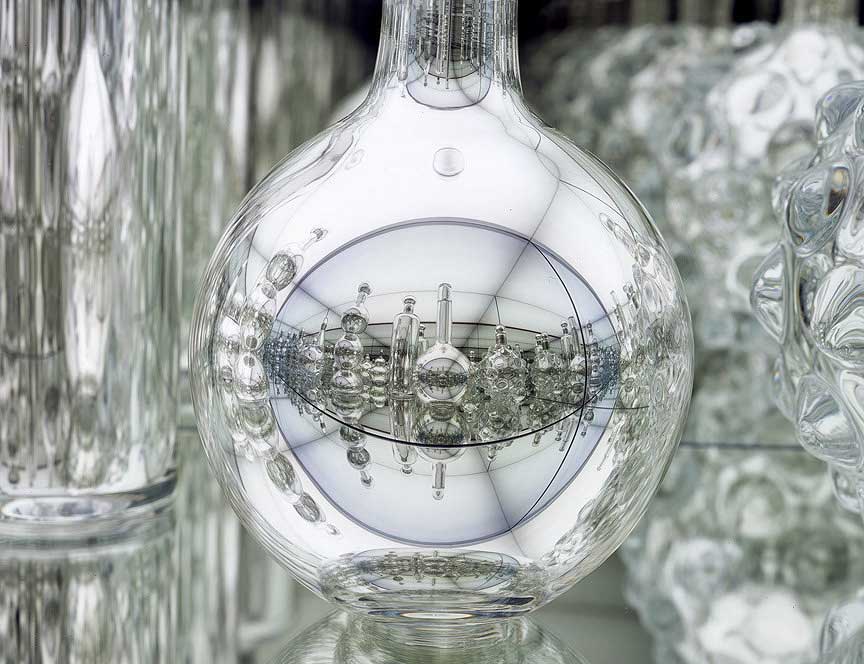Interview
Objects and Ideas

Josiah McElheny. From an Historical Anecdote about Fashion, 2000. Blown glass, wood, metal and glass display case, five framed digital prints. Display case dimensions: 72 x 120 x 28 inches. Digital prints: 18 x 25 1/2 inches each. Collection Whitney Museum of American Art, New York, NY. Photo by Tom Van Courtesy of Donald Young Gallery, Chicago.
Josiah McElheny discusses how he began working with glass, and his work’s relation to memory and history.
ART21: How did you decide to start working with glass?
MCELHENY: The way that I am is somewhat unusual. My education (art education) has led me to being an artist; a very important part of it was going to Europe and studying in these areas where they’ve always done glass manufacturing. The reason I went there in the first place was because I’d been told of a secretive romantic oral tradition—this glass manufacturing tradition only passed on person-to-person. These whole towns were involved over many hundreds of years in this endeavor to produce glass. Oftentimes the glass was for very wealthy people or aristocracy, in response to fashion. So, even if it was some isolated area, they were connected to culture in a bigger and wider sense, being involved with architects and artists who would come in and work with these factories to design tableware or specialty objects.
What I found very interesting was that this information only existed within this situation, and in order to learn it, you had to go and be part of this situation. At the time, I wasn’t thinking about being an artist; I was mostly just a person interested in going and experiencing what this might be like. Previous to that, I had been interested in art, but from the beginning, I thought of it not so much as this idea of expressing myself, but more as a way of participating in a group dialogue, trying to understand ideas. And to do that in a very direct way—not just reading about some philosophical idea but enacting it or experiencing it.
I was interested in is this idea of being an apprentice. In Europe, that’s still a very normal idea. Here in the United States, there are remnants of this kind of system of learning, but in general, it’s very anachronistic and unusual, so I had this romantic notion about it. And it sounds like it’s some guild system because of the glass factories’ unusual connection to the wider culture. They weren’t tradition-bound in the same sense of other endeavors, where not only is the tradition of how to make something continuous, but what is made is continuous.
ART21: Can say more about the process of working with glass?
MCELHENY: Glass is both special and difficult. Because it’s very easy for it to imitate other things, it’s in flux all the time. The people I studied with were very much involved in the invention of mid-century Modernism, so in some sense they were very far from the deep past. In another sense, they were very close to it because the way they were working was essentially unaltered for hundreds of years. They had figured out how to adapt this tradition to make modern objects.
One thing I always mention as a funny example is that the glass manufacturing process is a very unintuitive process. If you watched it, you wouldn’t imagine that a certain form would have started out in the shape that it does. If you want to make a classical Greek amphora, you have to first make a 1950s modern teardrop shape and then alter that into the amphora. Basically, what they did in collaboration with designers was try to figure out what was possible with this material, in line with the ideas of the day. So, they responded to what the process naturally did and, in doing so, helped invent this vocabulary of form.

Josiah McElheny. Adolf Loos’ Ornament and Crime, 2002. Blown glass, wood, glass, and electric lighting, case dimensions: 49 × 60 × 10 1/2 inches. Collection of the Detroit Institute of the Arts. Photo by Tom Van Eynde. Courtesy of Donald Young Gallery, Chicago.
ART21: What role does memory play in your work?
MCELHENY: A lot of my work comes from memory, in the sense that memory is always an imperfect remembrance. A lot of times, I will see something in a book, a photograph that actually misrepresents the original thing, and then I take that as being “real” and I run with that. Or, in another case, I will either downplay or play up the actual importance of something. So, I’m re-remembering, creating a new memory of this anecdote that’s not really real, in terms of what it was at that time, or what the meaning of those objects really were. I also think, lately, my work is a kind of memory of objects, in the sense that at one time these objects represented a deep striving for a certain idea of the world, and they don’t mean that anymore.
I made a series of works where I took some classic mid-century Modern furniture and decorative art objects—famous design objects—and had them all remade in white. There’s an element of it being a kind of display or history—or a whitewash (whatever you want to call it)—and it’s also supposed to be very seductive. Behind the whole thing is my notion that the ideas of our modern era are applied in, or infect, everything we do—so that even an idea of aesthetic beauty is not free from those associations. So, my idea of this whole series of white works is that you come in, and it’s this very luscious, beautiful place to be.
ART21: Say more about the sources that impact your work.
MCELHENY: Some people have asked me whether I have any desire to do something original. I often explain that a lot of my work, all of my work, is derived from some previous source, at some level; and that what I’m doing is re-imagining something or shifting or transforming it slightly, but always very much in connection to its source. I’m of the generation that doesn’t really believe in originality. It’s never occurred to me—this idea of originality being important.
One literary source that I found captivating as a child was Jorge Luis Borges. One of the attributes of many of his works is a kind of indecipherable line between fact and fiction. They are often fantastical but, at the same time, they often contain so much information that is real, that you can’t tell where one starts and the other stops. And I found that a very wonderful attitude. It’s very much in my work. I’m not expert on anything in terms of historical sources, but I’m interested in it, and I do feel that I have permission to play with it at some level. That’s something that is also in my own generation, that kind of awareness of history through education, but also just an awareness of the limits of authority and truth and anybody’s ability to make absolutely objective determination about anything. So, I think that I’ve just grown up with that.

Josiah McElheny. Modernity circa 1952, Mirrored and Reflected Infinitely, detail, 2004. Mirrored blown glass, chrome metal, glass, mirror, electric lighting; 30 1/2 × 56 1/2 × 18 1/2 inches. Collection Milwaukee Art Museum, Milwaukee, Wisconsin. Photo by Tom Van Eynde. Courtesy of Donald Young Gallery, Chicago.
ART21: What about history?
MCELHENY: I don’t really believe in history. And I think that, at some level, that’s one subject of some of my work—the fact that history is mutable, which is essentially denying history. So, either you can believe there is this thing called history, which is a linear narrative or in some general sense a linear narrative with a definable kind of thrust to it, or you could say that there’s just a lot of different stories. And if you believe that, which I would argue I believe, then you can’t really break with them. You could only reassemble them, possibly in some other way. Or you could add your own. I am interested in the past because for me it seems like a very rich thing to try to understand, especially because art is essentially a physical remnant of a moment.
You can have every idea that you want, but when you have to actually create some lasting thing, you bump up into reality. So, you have to translate your ideas somehow. And that creates art. As an artist, I’m interested in how art works—that art has lots of ideas behind it, and they somehow get embedded into the object. It’s not a question of deciphering what the original ideas are, but it’s letting those ideas be useful for me, now, in another way. That’s a big subject in my work—how ideas are contained in objects, and how the idea and the object can’t be disentangled. My belief is there is no such thing as the idea or the object. There is only a kind of fusion of the two.
ART21: Yet it’s hard to put finger on what that fusion is . . .
MCELHENY: If you assume that the artist or whoever’s making something has an intention, an idea of what they’re trying to do, basically whenever they try to do it, they are always failing. In terms of Renaissance art, if the actual notion is to communicate the relationship between Heaven and Hell, they failed at their intention. But in trying, they’ve infected the object with all these decisions and ideas. There’s information there, which is essentially the human effort to communicate, understand, and express ideas. And in every case it fails, but if the artist is engaged enough with what they’re doing, then maybe it will survive and can be translated into another set of ideas for people in another time, in another context.
An object that’s made today—we can have more connection to its intention because there could be literature about it that explains it in a language that’s very contemporaneous. If you look at the Abstract Expressionists, their whole language and the way they talked about art seems rather foreign at this point. It happens very quickly, this change. You lose the ability to know what was happening the moment that an artwork was made.
So, there’s only one thing left to do: re-imagine your own context for it. If the artwork is going to be useful, then you might as well feel like you have the right to invent a meaning for yourself. As an artist, it’s part of what my work is about. That’s what makes art interesting—that it’s completed by everybody else’s imagination. I’m not saying to disrespect history or not to read history, but ultimately you can’t access it. You can only access a series of stories that somebody had the power to publish. And that isn’t the truth—it’s just a story.



